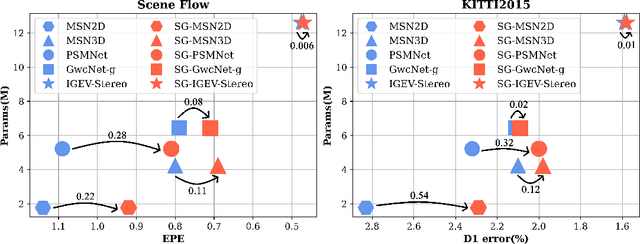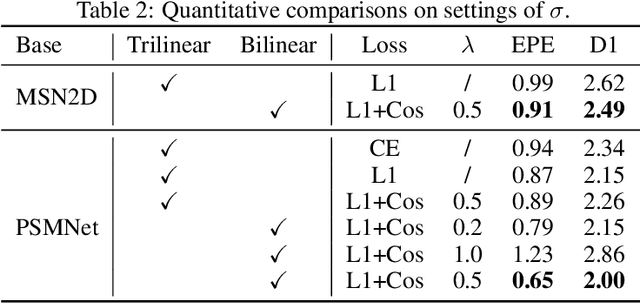Jun Cheng
Shenzhen Institute of Advanced Technology, Chinese Academy of Sciences
HMAD: Advancing E2E Driving with Anchored Offset Proposals and Simulation-Supervised Multi-target Scoring
May 29, 2025Abstract:End-to-end autonomous driving faces persistent challenges in both generating diverse, rule-compliant trajectories and robustly selecting the optimal path from these options via learned, multi-faceted evaluation. To address these challenges, we introduce HMAD, a framework integrating a distinctive Bird's-Eye-View (BEV) based trajectory proposal mechanism with learned multi-criteria scoring. HMAD leverages BEVFormer and employs learnable anchored queries, initialized from a trajectory dictionary and refined via iterative offset decoding (inspired by DiffusionDrive), to produce numerous diverse and stable candidate trajectories. A key innovation, our simulation-supervised scorer module, then evaluates these proposals against critical metrics including no at-fault collisions, drivable area compliance, comfortableness, and overall driving quality (i.e., extended PDM score). Demonstrating its efficacy, HMAD achieves a 44.5% driving score on the CVPR 2025 private test set. This work highlights the benefits of effectively decoupling robust trajectory generation from comprehensive, safety-aware learned scoring for advanced autonomous driving.
LiftFeat: 3D Geometry-Aware Local Feature Matching
May 06, 2025Abstract:Robust and efficient local feature matching plays a crucial role in applications such as SLAM and visual localization for robotics. Despite great progress, it is still very challenging to extract robust and discriminative visual features in scenarios with drastic lighting changes, low texture areas, or repetitive patterns. In this paper, we propose a new lightweight network called \textit{LiftFeat}, which lifts the robustness of raw descriptor by aggregating 3D geometric feature. Specifically, we first adopt a pre-trained monocular depth estimation model to generate pseudo surface normal label, supervising the extraction of 3D geometric feature in terms of predicted surface normal. We then design a 3D geometry-aware feature lifting module to fuse surface normal feature with raw 2D descriptor feature. Integrating such 3D geometric feature enhances the discriminative ability of 2D feature description in extreme conditions. Extensive experimental results on relative pose estimation, homography estimation, and visual localization tasks, demonstrate that our LiftFeat outperforms some lightweight state-of-the-art methods. Code will be released at : https://github.com/lyp-deeplearning/LiftFeat.
The Tenth NTIRE 2025 Image Denoising Challenge Report
Apr 16, 2025Abstract:This paper presents an overview of the NTIRE 2025 Image Denoising Challenge ({\sigma} = 50), highlighting the proposed methodologies and corresponding results. The primary objective is to develop a network architecture capable of achieving high-quality denoising performance, quantitatively evaluated using PSNR, without constraints on computational complexity or model size. The task assumes independent additive white Gaussian noise (AWGN) with a fixed noise level of 50. A total of 290 participants registered for the challenge, with 20 teams successfully submitting valid results, providing insights into the current state-of-the-art in image denoising.
UCS: A Universal Model for Curvilinear Structure Segmentation
Apr 05, 2025Abstract:Curvilinear structure segmentation (CSS) is vital in various domains, including medical imaging, landscape analysis, industrial surface inspection, and plant analysis. While existing methods achieve high performance within specific domains, their generalizability is limited. On the other hand, large-scale models such as Segment Anything Model (SAM) exhibit strong generalization but are not optimized for curvilinear structures. Existing adaptations of SAM primarily focus on general object segmentation and lack specialized design for CSS tasks. To bridge this gap, we propose the Universal Curvilinear structure Segmentation (\textit{UCS}) model, which adapts SAM to CSS tasks while enhancing its generalization. \textit{UCS} features a novel encoder architecture integrating a pretrained SAM encoder with two innovations: a Sparse Adapter, strategically inserted to inherit the pre-trained SAM encoder's generalization capability while minimizing the number of fine-tuning parameters, and a Prompt Generation module, which leverages Fast Fourier Transform with a high-pass filter to generate curve-specific prompts. Furthermore, the \textit{UCS} incorporates a mask decoder that eliminates reliance on manual interaction through a dual-compression module: a Hierarchical Feature Compression module, which aggregates the outputs of the sampled encoder to enhance detail preservation, and a Guidance Feature Compression module, which extracts and compresses image-driven guidance features. Evaluated on a comprehensive multi-domain dataset, including an in-house dataset covering eight natural curvilinear structures, \textit{UCS} demonstrates state-of-the-art generalization and open-set segmentation performance across medical, engineering, natural, and plant imagery, establishing a new benchmark for universal CSS.
Beyond Existance: Fulfill 3D Reconstructed Scenes with Pseudo Details
Mar 06, 2025Abstract:The emergence of 3D Gaussian Splatting (3D-GS) has significantly advanced 3D reconstruction by providing high fidelity and fast training speeds across various scenarios. While recent efforts have mainly focused on improving model structures to compress data volume or reduce artifacts during zoom-in and zoom-out operations, they often overlook an underlying issue: training sampling deficiency. In zoomed-in views, Gaussian primitives can appear unregulated and distorted due to their dilation limitations and the insufficient availability of scale-specific training samples. Consequently, incorporating pseudo-details that ensure the completeness and alignment of the scene becomes essential. In this paper, we introduce a new training method that integrates diffusion models and multi-scale training using pseudo-ground-truth data. This approach not only notably mitigates the dilation and zoomed-in artifacts but also enriches reconstructed scenes with precise details out of existing scenarios. Our method achieves state-of-the-art performance across various benchmarks and extends the capabilities of 3D reconstruction beyond training datasets.
MIFNet: Learning Modality-Invariant Features for Generalizable Multimodal Image Matching
Jan 20, 2025



Abstract:Many keypoint detection and description methods have been proposed for image matching or registration. While these methods demonstrate promising performance for single-modality image matching, they often struggle with multimodal data because the descriptors trained on single-modality data tend to lack robustness against the non-linear variations present in multimodal data. Extending such methods to multimodal image matching often requires well-aligned multimodal data to learn modality-invariant descriptors. However, acquiring such data is often costly and impractical in many real-world scenarios. To address this challenge, we propose a modality-invariant feature learning network (MIFNet) to compute modality-invariant features for keypoint descriptions in multimodal image matching using only single-modality training data. Specifically, we propose a novel latent feature aggregation module and a cumulative hybrid aggregation module to enhance the base keypoint descriptors trained on single-modality data by leveraging pre-trained features from Stable Diffusion models. We validate our method with recent keypoint detection and description methods in three multimodal retinal image datasets (CF-FA, CF-OCT, EMA-OCTA) and two remote sensing datasets (Optical-SAR and Optical-NIR). Extensive experiments demonstrate that the proposed MIFNet is able to learn modality-invariant feature for multimodal image matching without accessing the targeted modality and has good zero-shot generalization ability. The source code will be made publicly available.
EchoONE: Segmenting Multiple echocardiography Planes in One Model
Dec 04, 2024Abstract:In clinical practice of echocardiography examinations, multiple planes containing the heart structures of different view are usually required in screening, diagnosis and treatment of cardiac disease. AI models for echocardiography have to be tailored for each specific plane due to the dramatic structure differences, thus resulting in repetition development and extra complexity. Effective solution for such a multi-plane segmentation (MPS) problem is highly demanded for medical images, yet has not been well investigated. In this paper, we propose a novel solution, EchoONE, for this problem with a SAM-based segmentation architecture, a prior-composable mask learning (PC-Mask) module for semantic-aware dense prompt generation, and a learnable CNN-branch with a simple yet effective local feature fusion and adaption (LFFA) module for SAM adapting. We extensively evaluated our method on multiple internal and external echocardiography datasets, and achieved consistently state-of-the-art performance for multi-source datasets with different heart planes. This is the first time that the MPS problem is solved in one model for echocardiography data. The code will be available at https://github.com/a2502503/EchoONE.
Diffusion Priors for Variational Likelihood Estimation and Image Denoising
Oct 23, 2024



Abstract:Real-world noise removal is crucial in low-level computer vision. Due to the remarkable generation capabilities of diffusion models, recent attention has shifted towards leveraging diffusion priors for image restoration tasks. However, existing diffusion priors-based methods either consider simple noise types or rely on approximate posterior estimation, limiting their effectiveness in addressing structured and signal-dependent noise commonly found in real-world images. In this paper, we build upon diffusion priors and propose adaptive likelihood estimation and MAP inference during the reverse diffusion process to tackle real-world noise. We introduce an independent, non-identically distributed likelihood combined with the noise precision (inverse variance) prior and dynamically infer the precision posterior using variational Bayes during the generation process. Meanwhile, we rectify the estimated noise variance through local Gaussian convolution. The final denoised image is obtained by propagating intermediate MAP solutions that balance the updated likelihood and diffusion prior. Additionally, we explore the local diffusion prior inherent in low-resolution diffusion models, enabling direct handling of high-resolution noisy images. Extensive experiments and analyses on diverse real-world datasets demonstrate the effectiveness of our method. Code is available at https://github.com/HUST-Tan/DiffusionVI.
The Sampling-Gaussian for stereo matching
Oct 09, 2024



Abstract:The soft-argmax operation is widely adopted in neural network-based stereo matching methods to enable differentiable regression of disparity. However, network trained with soft-argmax is prone to being multimodal due to absence of explicit constraint to the shape of the probability distribution. Previous methods leverages Laplacian distribution and cross-entropy for training but failed to effectively improve the accuracy and even compromises the efficiency of the network. In this paper, we conduct a detailed analysis of the previous distribution-based methods and propose a novel supervision method for stereo matching, Sampling-Gaussian. We sample from the Gaussian distribution for supervision. Moreover, we interpret the training as minimizing the distance in vector space and propose a combined loss of L1 loss and cosine similarity loss. Additionally, we leveraged bilinear interpolation to upsample the cost volume. Our method can be directly applied to any soft-argmax-based stereo matching method without a reduction in efficiency. We have conducted comprehensive experiments to demonstrate the superior performance of our Sampling-Gaussian. The experimental results prove that we have achieved better accuracy on five baseline methods and two datasets. Our method is easy to implement, and the code is available online.
Ctrl-GenAug: Controllable Generative Augmentation for Medical Sequence Classification
Sep 25, 2024



Abstract:In the medical field, the limited availability of large-scale datasets and labor-intensive annotation processes hinder the performance of deep models. Diffusion-based generative augmentation approaches present a promising solution to this issue, having been proven effective in advancing downstream medical recognition tasks. Nevertheless, existing works lack sufficient semantic and sequential steerability for challenging video/3D sequence generation, and neglect quality control of noisy synthesized samples, resulting in unreliable synthetic databases and severely limiting the performance of downstream tasks. In this work, we present Ctrl-GenAug, a novel and general generative augmentation framework that enables highly semantic- and sequential-customized sequence synthesis and suppresses incorrectly synthesized samples, to aid medical sequence classification. Specifically, we first design a multimodal conditions-guided sequence generator for controllably synthesizing diagnosis-promotive samples. A sequential augmentation module is integrated to enhance the temporal/stereoscopic coherence of generated samples. Then, we propose a noisy synthetic data filter to suppress unreliable cases at semantic and sequential levels. Extensive experiments on 3 medical datasets, using 11 networks trained on 3 paradigms, comprehensively analyze the effectiveness and generality of Ctrl-GenAug, particularly in underrepresented high-risk populations and out-domain conditions.
 Add to Chrome
Add to Chrome Add to Firefox
Add to Firefox Add to Edge
Add to Edge